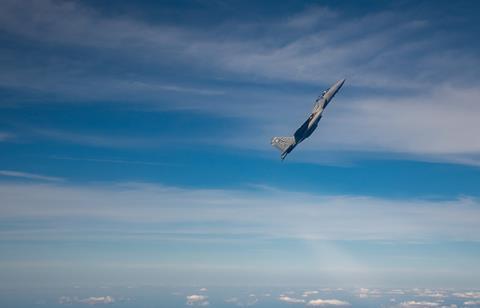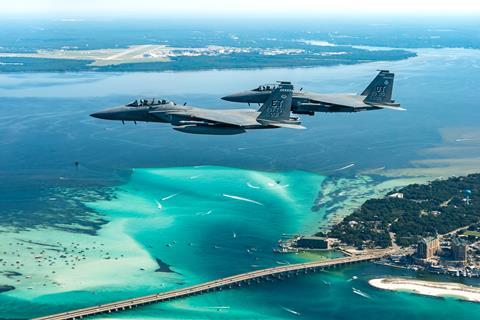Boeing and the US Air Force (USAF) have finalised terms for the next three rounds of production on the modernised F-15EX Eagle II fighter.
The $3.9 billion contract covers 48 aircraft in Lots 2 through 4, bringing total USAF commitments for the F-15EX to 56. The previously agreed Lot 1 contract from 2020 covered eight jets, including the two test aircraft already delivered to the air force.

The USAF confirmed the latest deal to FlightGlobal on 6 November, noting the terms of the contract were made definitive on 28 September. The deal also funds the purchase of long-lead items for Lot 5 aircraft.
Notably, the latest pricing agreements make the fourth-generation F-15EX more expensive per aircraft than Lockheed Martin’s F-35A, which incorporates advanced stealth technology.
Under the recent contract, the USAF will pay $90 million for each F-15EX in production Lot 2, with the cost spiking to $97 million each in Lot 3 before sliding back to $94 million in Lot 4.
The three rounds of production collectively cover the 48 aircraft, plus major items such as combat radars, the BAE Systems Eagle Passive Warning Survivability electronic warfare system and the two GE Aerospace F110-129 engines that power each jet.
By contrast, the USAF will pay an average of $82.5 million for each F-35A under the latest production contract negotiated between Lockheed and the Pentagon’s multi-service F-35 procurement office.
That deal, valued at $30 billion, covers 398 F-35s produced under Lots 15 through 17. The more-complex F-35B short take-off and vertical landing variant, as well as the US Navy’s carrier-capable F-35Cs, are priced at $109 million and $102 million each respectively, according to the Pentagon.
The price differential between F-15s and F-35s is sure to attract scrutiny in Congress, where some members have previously expressed scepticism about making further investments in fourth-generation aircraft.

Boeing has billed the F-15EX as a “4.5-generation” fighter, with modernised sensors, communications and electronic countermeasures that make the Eagle II more advanced than earlier F-15 models.
Additionally, the type boasts a significantly greater payload than the F-35, which typically carries weapons and fuel internally to maintain the fifth-generation jet’s low-observable profile. The F-35 can boost its weapons payload by carrying missiles externally, albiet at the expense of stealthiness.
The USAF’s F-15EX test aircraft have proved capable of carrying 12 underwing missiles and three Lockhed AGM-158 Joint Air-to-Surface Standoff Missiles, during separate tests in recent months.
Boeing argues such firepower makes Eagle IIs ideal for backing up stealthy F-35s.
While the USAF now plans to acquire up to 104 F-15EXs, that number has fluctuated in recent years. The service originally planned to buy 144 of the fighters, but at one point cut the number to as few as 80 aircraft before settling on the current figure.
Amid some uncertainty on the final size of the US fleet, Boeing is marketing the F-15EX to overseas customers.
Indonesia in August signed a memorandum of understanding with Boeing to acquire up to 24 Eagle II fighters, although that deal has not been finalised.
US arms regulators in 2022 approved the sale to Indonesia of 36 F-15ID fighters – an Indonesia-specific variant based on the F-15EX. That sale was valued at $13.9 billion by the Defense Security Cooperation Agency.
Boeing is also pitching the F-15EX to Poland, as that country seeks to dramatically expand its air-combat capabilities. Warsaw plans to acquire 32 F-35As from Lockheed; those jets are currently under production.
Poland is also acquiring 48 Korea Aerospace Industries FA-50 light fighters as a means to rapidly modernise its current fleet from Soviet-era fighter aircraft.


























